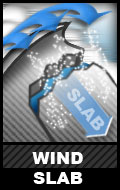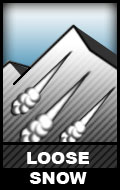Weekend Avalanche Outlook
Dangerous avalanche conditions. Cautious route-finding, conservative decision-making, and careful snowpack evaluation will be essential for traveling safely in and around avalanche terrain this weekend. Natural avalanches are possible, and human triggered avalanches are likely. Small avalanches may occur in many areas, large avalanches in specific areas, and very large avalanches in isolated areas.
Anchorage has received a few inches of new snow overnight, and a few more inches are expected through Saturday. Accumulation may be higher in the mountains, especially those just north of Anchorage. There have been some moderate winds capable of building fresh, relatively soft wind slabs on leeward (primarily northerly) aspects. Strong winds earlier this week, along with the new snow, will contribute to dangerous avalanche conditions this weekend.
Low visibility due to new snow and low clouds will increase the danger of backcountry travel in and around avalanche terrain through Saturday, and possibly Sunday.
Expect light, but steady snowfall through Saturday with more accumulation to the north of Anchorage. Alpine temps will be in the 20s with generally light to moderate SW to W wind (although terrain channeling creates variable wind patterns across the park).
Some clearing skies are expected Sunday, but the possibility of snow showers remains. Temperatures will cool slightly and winds should remain generally light, but there is the possibility of moderate winds loading leeward upper elevation aspects as there will be plenty of light and low density new snow available for transport into wind slabs.
Very spooky avalanche conditions have been reported throughout the week. Check the recent observations.
__________
Recognize red flags of avalanche danger. Acknowledge increased danger from new snow and wind. Be on the lookout for recent avalanches. “Whumphing,” or collapsing, and shooting cracks are glaring red flags.
Be mindful of terrain traps, and exposure to overhead avalanche danger. Avalanches triggered in the upper elevations have the potential to run into lower elevation, even flat, terrain. Many trails in Chugach State Park cross dangerous avalanche paths (including Penguin Ridge, Falls Creek, Rabbit Creek, Powerline, O’Malley Gully, South Fork Eagle River, and Iditarod-Crow Pass). A basic level of avalanche awareness, such as that gained through a free or low-cost class, will help you be able to identify problem areas.
__________
Avalanche Problems:
D1-D2 human triggered wind slabs are likely in specific areas: wind loaded and cross loaded upper elevation leeward terrain steeper than ~35*. These areas will primarily be above 2500′ near ridges and peaks, and along gully sidewalls. Problems may be identified by deeper snow with slightly stiffer snow near the surface, often with shooting cracks and/or a relatively punchy or hollow feel. Quick assessment via pole probing, hand pits, and paying close attention to the way snow feels as you travel will help you get a handle on this problem.
D1-D2.5 persistent slabs are possible in specific upper elevation areas steeper than 35*. The persistent slab problem is expected to be in similar areas to the wind slab problem, where a trigger may propagate a fracture through an older, more deeply buried persistent weak layer. These weak layers are expected to be the most reactive near “sweet spots” like rocks, rollovers, and where the snowpack is thinner and/or less supportable. It will take careful snowpack evaluation, like snowpits with stability tests and layer analysis, to get a handle on this problem.
Generally small (D1) loose snow avalanches are possible on steep, sheltered terrain. While these are expected to be small and not inherently dangerous, keep terrain traps and exposure in mind. While these small sluffs won’t bury you, they could make you fall or lose control.
Cornices are still generally small, and aren’t expected to be too problematic this weekend. However, give theme a wide berth and don’t approach a potentially corniced ridge to look down slope. Cornice falls pose an inherent hazard, as well as their ability to trigger an avalanche when they fall on a slope.
__________
Many avalanche accidents that have happened in Anchorage’s backyard of Chugach State Park could have been prevented by basic avalanche awareness. If you don’t have this level of awareness, here are some online resources to help you start the learning process. There are also numerous options for getting a real avalanche education locally. Many of these learning opportunities are even FREE. Here’s info on a free opportunity at Anchorage REI on Wednesday, February 8 from 6:00-7:30pm.
Chugach State Park now has a base for reasonable alpine touring. Keep in mind that hazards such as superficially covered rocks and vegetation exist.
*click problem icons and hyperlinked terms for further info



